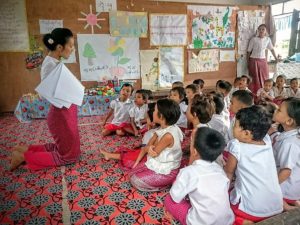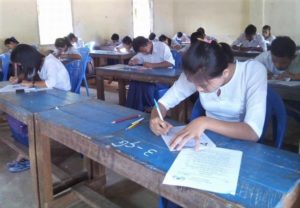
A MNEC teacher delivers a lesson to Mon students in their mother tongue
Agreements bring further progress towards the PLE Education Convergence Strategy
The Mon National Education Committee (MNEC) is the first ethnic organization to formally collaborate with the Burma Ministry of Education (MoE) via the Mon State Education Department. In 1995 students studying at MNEC supported high schools sat for the National Matriculation Exam for the first time following the signing of the National Ceasefire Agreement. The agreement allowed students from MNEC schools to both transfer to government schools and to sit for the standard matriculation exam, meaning that all students completing education through the Mon National System (MNS) were permitted to take the same accredited exam that students attending government schools take each year to graduate from secondary school.
In order to be eligible to apply for university, MNS students need to take the Grade 10 Matriculation Exam at a government school. Government restructuring of the regional exam system to introduce additional exams at Grade 8 met resistance due to fears that it would undermine the Mon mother tongue aspects of the MNEC curriculum at the earlier grades and add an extra barrier to them being able to access MoE universities. As the exam is in the Myanmar language students would have less time to study through their mother tongue. However, following a survey with the community to assess their attitudes toward the Grade 8 exam, PLE-facilitated negotiations and discussions between the Ministry of Education and MNEC, as well as with ethnic leadership and MNEC, a solution was found that was acceptable to all.
MNEC and the MoE agreed to jointly manage the Grade 8 assessments and hold them in Mon schools. Six MNEC teachers have been selected to mark the exams, alongside MoE teachers. The agreement to incorporate Grade 8 exams at Mon schools also means that MNEC school transfer certificates guarantee Grade 9 entry into government schools, giving Mon students the security of starting their education in Mon language, but being able to transfer to state universities.
This agreement is a good example of how MNEC has been using community-based decision making to assure that their efforts to ensure recognition of the MNS by the Government of Burma are in line with the needs of the local communities in which they live.
MNEC provides educational services to vulnerable children in Mon State as well as some parts of Karen State and Tenasserim Division. MNEC was founded by the New Mon State Party (NMSP) in 1972 with the aim “to provide high quality education to Mon youth in their mother tongue.” The MNS education system allows students to receive a mother tongue based education while incorporating Myanmar as a principle language. MNEC supports over 30,000 students to attend formal basic education in 245 schools in Southeast Burma and provides specialized training and capacity building opportunities to strengthen the capacity of nearly 800 teachers. It advocates for the recognition of the learning achievements of Mon students and for accreditation for the teachers it trains and supports.

A Grade 10 student takes a pre-matriculation exam in preparation to sit for and pass the Grade 10 Matriculation Exam
Mission/Vision: MNEC is dedicated to creating a society that provides its people with basic education to enable all ethnic groups to peacefully coexist.
Link to PLE Strategy: MNEC promotes increased access to education services for vulnerable populations in Southeast Burma through the administration of Mon State schools, curriculum development, and the recruiting, training and support to teachers. In PY6, MNEC will continue to strengthen management structures and quality of educational intervention, including the refinement of parent-teacher associations (PTAs), equivalency mechanisms, matriculation exams, and propose further models of recognition towards convergence goals.
Partnership period: 1st April 2014 – 31st July 2017
Project location(s): Mon State, Karen State and Tanintharyi Region, Burma
Project beneficiaries (direct & indirect): Mon Students and teachers attending non-state and mixed schools
